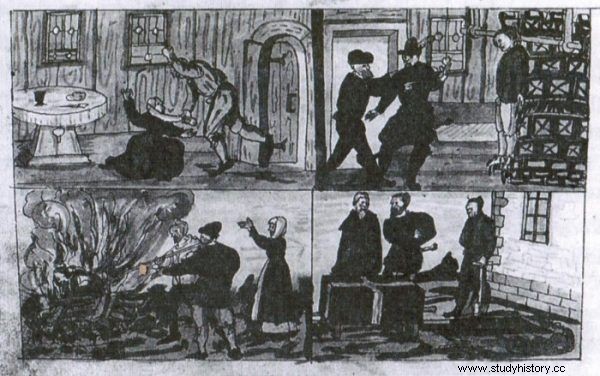Suicides today arouse shock, disbelief, and often sympathy. But no one would think of ... punishing suicides. Meanwhile, from the Middle Ages to the 18th century, suicide was considered a serious crime, on a par with abortion, incest, arson or even murder. As such, it deserved the heaviest punishment possible. But how do you execute a death sentence on someone who has already killed himself?
It may seem quite pointless to peasant reason, but the inhabitants of old Europe carried out suicide executions with the stubbornness of a maniac. And it's extremely fancy! On the one hand, it was about adhering to the law, on the other hand, it was simply fearing those who had passed away in such a wrong way.

An often used "punishment" for a suicide was hanging his body in a public place.
It was assumed that if the corpse was punished severely enough, it would not want to come back from the underworld and make life difficult for his loved ones. Maybe there was some sense in this, although I, in the place of our ancestors, would prefer such a deceased not to move at all ... so that he would not take revenge sometimes.
How do I get rid of a suicide corpse?
It was difficult to carry the suicide's body out of the house (if that was where he killed himself). In Nuremberg, the corpse was thrown out the window, and necessarily at night. In Germany, it was also often recommended to carry the corpse through the roof, which had to be dismantled. Among other things, in France it was recommended ... to demolish one of the walls of the house and throw a suicide through such an opening.
In the worst cases, the family could face the destruction of the entire home, as well as the confiscation of the property of the "criminal". Against this background, the obligation to drag a corpse under the threshold seems to be a trifle. It also required some "structural adjustments", but not tearing off the entire roof or tearing down the walls and risking the house collapsing.

Suicide on a Swiss engraving from the 16th century. The man killed himself as a result of an unsuccessful marriage ... what was done with him can be seen perfectly above (photo from the book by Paweł Duma).
The most macabre, however, was the continuation. Those suicides were lucky, as they were buried at a crossroads, in a forest or behind a cemetery wall, simply without the Holy Mass and holy water. Those whose bodies were thrown in the garbage bin also finished quite well . In many cases, however, the troupe faced a show of punishment, as a warning to all those who thought about taking their own lives.
From burning to melting
It was common practice to smoke suicides or hanging them on the gallows . As Paweł Duma, the author of the book "Trób alienata", writes, in Nuremberg it happened that the corpses of suicides were taken out of the gate, where the body was burned at the first intersection or in the middle of nowhere.
More often, however, the authorities of this center decided to drown people who took their own lives. The body used to put into barrels and throw it into rivers and . In Zurich in 1417, this was the treatment of a suicide parish priest. Although it was initially buried in the cemetery, the weather deteriorated then, and the population - noticing the cause-and-effect relationship - dug up the corpse and threw it into the river bed. In the case of a certain suicide who killed himself in 1516 in Frankfurt am Main, a more careful rite was decided. Paweł Duma writes:
After dragging the suicide, a short trial was carried out, after which the body was put into an old barrel, a gallows was painted on it and thrown into the Menu.

It happened that when a suicide had other crimes on his conscience, breaking the wheel was added to the repertoire of punishments.
The Basel suicide "finished" similarly in 1532, but as he was also guilty of murdering his wife and child, he was additionally broken with a wheel . In many regions, drowning was preferred not in rivers, but in swamps, which seemed to be the perfect match for rogue suicides.

The article is based on the book by Paweł Duma entitled Alienata's tomb. Burials of unbaptized children, suicides and convicts in the late Middle Ages and the early modern era (Avalon, 2010).
In 1872, in the town of Wang in Upper Bavaria, the body of a journeyman who hanged himself in a [neighboring] village (...) was thrown into a nearby quagmire . At the same time, in Gręboszów, Małopolska, suicides were still drowned ... in a shallow ditch near the cemetery.
Besides, suicide corpses were often had their heads cut off - moreover, to protect against their return from the underworld, than to punish. This is how the executioner dealt with a woman in Gryfów Śląski in 1731. Sources confirm that also in Białobrzegi near Łańcut, suicide victims were cut off their heads and buried face down. In England, on the other hand, until the beginning of the 19th century, the corpses of suicides were pierced with a stake .
As you can see, the civilized treatment of unfortunates who took their own lives is a relative novelty in European culture ...
Source:
- Paweł Duma, Tomb of alienata. Burials of unbaptized children, suicides and convicts in the late Middle Ages and the early modern era , Avalon, 2010.
